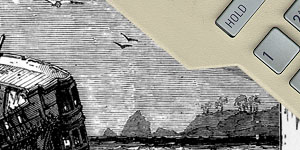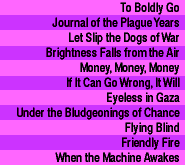


Flying Blind
Shortly after nine in the morning on Saturday, June 30, 1956, two planes took off from Los Angeles airport. Trans World Airlines Flight 2 was bound for Kansas City, and United Airlines Flight 718 was bound for Chicago. In total, they carried 128 people.In those days, no computers continuously monitored air traffic. Both pilots followed procedure and periodically called in their positions as they followed their flight plans. The nearest air control station picked up the reports and sent them by telephone to the nearest regional air control station. There they were printed on long rolls of paper. Human controllers monitoring the flights sat in front of tall racks holding up to twenty or more of such paper strips.
Once the two planes left the Los Angeles terminal area they were in uncontrolled airspace. Neither was being directed from the ground, and neither knew of the other's presence. Both planes were scheduled to pass over the Painted Desert checkpoint near Salt Lake City at half past ten. At 10:31 that morning Salt Lake Control heard: ``Salt Lake, United 718... ah... we're going in.'' The two planes had collided in the clouds high above the Painted Desert. No one survived the crash and the long slow fall into the Grand Canyon.
A huge public outcry followed the crash. Within months, military radars were pressed into service to help monitor commercial flights. Two years later, the U.S. Congress created an agency, which later became the Federal Aviation Administration, to oversee development of a huge computer installation to monitor flights and detect potential collisions.
Nonetheless, on Friday, December 16, 1960, another Trans World Airlines flight collided with another United Airlines flight over New York City. This time, 134 people were killed---128 in the air and 6 on the ground.
Even in the 1950s, the huge volume of information about clear air turbulence, wind, weather, microbursts, aircraft capabilities, flight plans, routes, positions, speeds, altitudes, flocks of geese, and so on, was far beyond anything we could monitor unaided. But monitor them we must; birds don't file flight plans and microbursts don't check in with the weather bureau.
By the early 1980s, American air traffic control systems alone had already consumed over five hundred programmer-years of work and constituted a computer program more than half a million lines long. Since then, it has grown threefold. And it can't be replaced wholesale because it must function every minute of every day.
As a result, enormous ancient computers designed in the 1950s and 1960s, which have speeds and memories thousands of times smaller than today's simple personal computers, are still being used to control American air traffic. Today, thanks to bureaucratic ineptitude and political squabbling, air traffic controllers are still the world's largest consumers of vacuum-tube computers.
And the control problem has grown. Today nearly half the people who fly, do so over the North American continent. Air traffic over America already exceeds 450 million passengers a year and is projected to grow to a thousand million by the year 2000. Almost 120 planes take off or land every minute in America alone, and every day they carry a total of 1.5 million passengers. As you read this, over a million people are in the air above North America. And the numbers keep increasing.
Yes, our computer systems have limits, and, yes, our computer systems are unsafe. But then everything has limits, and everything is unsafe. What matters is how unsafe it is with respect to all the other things we consider safe enough. Unlike soda bottles or trains or electric wall plugs, computer systems are new enough and strange enough that we still notice all their failings. It's already far too late, however, to replace them with people. We aren't fast enough; we aren't cheap enough; and we aren't numerous enough.
Now reduced to ghosts in the machine of our technology, we've already passed the point of no return and are blindly flying down a path of more and yet more dependence on computers, hoping against hope that there isn't a Painted Desert in our future.